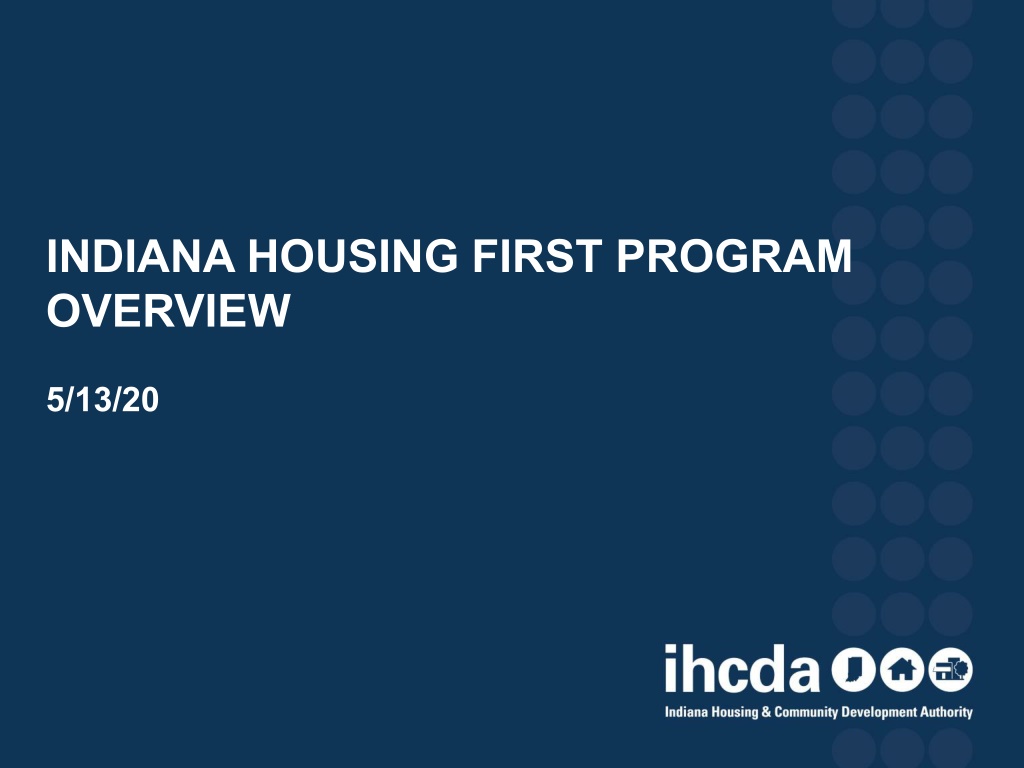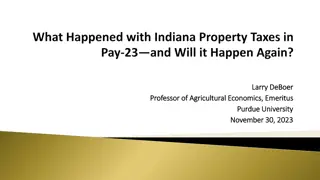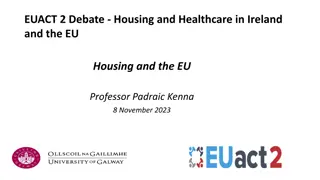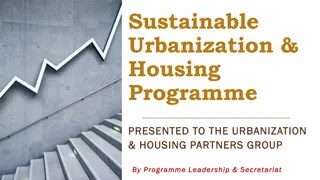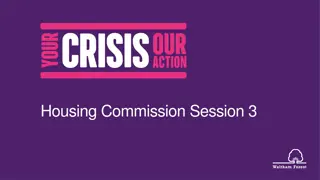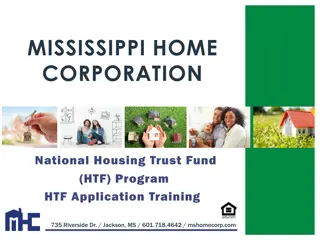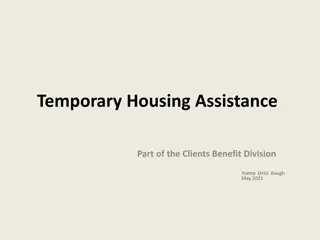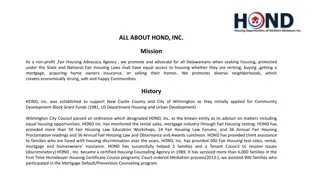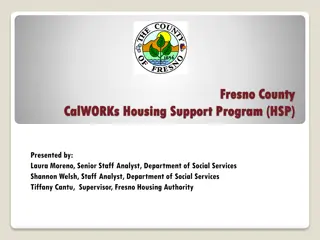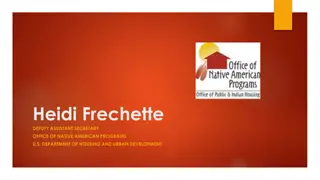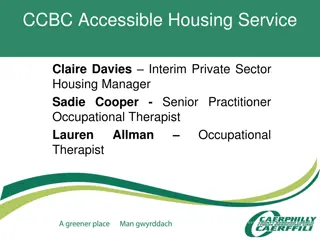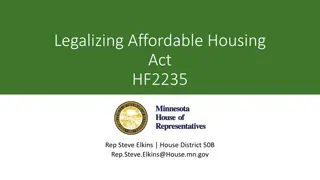Indiana Housing First Program Overview
The Indiana Housing First Program was established in 2017 to provide rental assistance and support services to individuals and families with mental illness or addiction facing housing crises. Services are voluntary, person-centered, and follow a harm reduction approach. The program utilizes the Critical Time Intervention (CTI) model to build long-lasting stability and community support networks.
Download Presentation

Please find below an Image/Link to download the presentation.
The content on the website is provided AS IS for your information and personal use only. It may not be sold, licensed, or shared on other websites without obtaining consent from the author.If you encounter any issues during the download, it is possible that the publisher has removed the file from their server.
You are allowed to download the files provided on this website for personal or commercial use, subject to the condition that they are used lawfully. All files are the property of their respective owners.
The content on the website is provided AS IS for your information and personal use only. It may not be sold, licensed, or shared on other websites without obtaining consent from the author.
E N D
Presentation Transcript
INDIANA HOUSING FIRST PROGRAM OVERVIEW 5/13/20
Indiana Housing First Program POLICY MANUAL OVERVIEW
PURPOSE OF THE HOUSING FIRST PROGRAM The Indiana Housing First Program ( the program ) was created in 2017 by the state general assembly to provide rental assistance and support services to individuals and families with a serious, persistent mental illness, a chronic chemical addiction, or a serious and persistent mental illness with a co- occurring chronic chemical addiction, who are also facing a housing crisis. Program regulations may be found in Indiana Code 5-20-9
STRATEGY HOUSING FIRST Services provided are voluntary Selected by program participants Focus is on engagement Small case loads Person-centered approach Harm reduction approach to addictions, cannot mandate abstinence Participants must have typical lease, with all rights and responsibilities Cannot deny entry to participants for: Having too little or no income Active or history of substance use Cannot terminate participants for: Failure to participate in supportive services Failure to make progress on a service plan Loss of income or failure to improve income Any activity not covered in the participant s lease agreement
STRATEGY CTI The program follows a Critical Time Intervention (CTI) approach to providing assistance Goal of CTI is to build long-lasting stability by developing a community support network around the individual or household and providing support during the time of transition The relationships built in the community are expected to outlast the financial assistance provided by the program Evidence based practice that has been demonstrated to be effective at providing housing assistance to individuals with serious mental illness Recognized by the Substance Abuse and Mental Health Services Administration (SAMHSA) in the National Registry of Evidence-based Programs and Practices
STRATEGY CTI CTI Case Managers typically have small caseloads of approximately 15 clients Typical model lasts 9 months, and is divided into 3 stages
PARTICIPANT ELIGIBILITY Addiction and/or Mental Illness Exiting Residential Treatment Living in an Institution Homeless
PARTICIPANT ELIGIBILITY An eligible participant in the program is defined as: an individual with a serious mental illness, a chronic chemical addiction, or a serious and persistent mental illness with a co-occurring chronic chemical addiction, resulting in a housing crisis (defined on next slide). Participants do not have to income qualify at initial enrollment and there is no maximum income limit. However, for a participant to receive more than 12 months of assistance, the participant s household income must be certified as having an annual income at or below 30% of the area median income (AMI) as published annually by HUD. Recipients may not establish a minimum income requirement for the Program, and must accept households with little or no income
PARTICIPANT ELIGIBILITY A Housing Crisis is defined as: a situation in which an individual or a household does not have sufficient resources or support networks immediately available to maintain safe and affordable housing or to prevent the individual or household from requiring emergency housing. A household is determined to be in a housing crisis if they meet one of the following conditions: They are residing on the street or a place not meant for human habitation; They are residing in temporary housing, including emergency shelter, transitional housing, or are currently staying with family or friends on a temporary basis and must imminently vacate; They are facing an imminent court-ordered eviction. A household served under this definition is only eligible for a one time arrears payment to prevent eviction and prevent homelessness, but can be served with ongoing services. They are exiting a residential treatment program and do not have immediate access to permanent housing; They are living in an institution or other restrictive setting; and could, with stable and affordable housing provided by this program, along with community and home based supports, live independently in the community.
PARTICIPANT SELECTION PLAN In addition to meeting the eligibility definitions above, recipients must prioritize serving eligible persons who are medically vulnerable Most grantees use the CES system Referrals from treatment providers for de-institutionalization focused program
ELIGIBLE COSTS Program funds can be used for: Tenant-Based Rental assistance (70% of funds) Supportive services (20% of funds) Administrative costs (10% of funds) Participants do not have to be enrolled in supportive services to receive rental assistance and vice versa
ELIGIBLE COSTS RENTAL ASSISTANCE At least 70% of the overall grant amount must be used for rental payments and other eligible housing costs as defined below: Rent payments and other housing costs must be paid by the recipient directly to a third-party on behalf of the household. The contract rent (charged by the landlord) plus a utility allowance (if utilities are not included in the rent) must be determined to be reasonable. The household must pay at least 30% of their monthly adjusted income toward housing costs. The program can pay the rest of the rent depending on the subsidy model that the recipient has chosen Rental payments are limited to 24 months of assistance per household per episode of housing crisis.
ELIGIBLE COSTS RENTAL ASSISTANCE & OTHER HOUSING COSTS Monthly rental payments and first and last months rent if required by owner Security deposits of up to the value of two months of rent Up to three months of rental arrears and associated late fees may be paid if their payment is necessary for the household to obtain or maintain permanent housing. Utilities which are included in the rent Up to three months of utility arrears, if this payment is necessary for the household to obtain or maintain utilities in a unit for which they are receiving rental assistance. Utility deposits and ongoing utility payments (not to exceed the IHCDA published utility allowance for the county) for households receiving rental assistance. Application fees or background checks required by the property owner to obtain housing. One-time moving fees.
ELIGIBLE COSTS SUPPORTIVE SERVICES Supportive services funds may not exceed 20% of the overall grant amount. Employment assistance and job training. Substance abuse and addiction treatment. Educational assistance. Life skills assistance. Treatment for, and the management of, mental and physical health problems. Developing individualized housing and service plans. Transportation assistance. Assessment of service needs. Legal services. Child care assistance. Provide housing stability case management services. Developing plans, making referrals, or connecting to the types of services listed above.
ELIGIBLE COSTS ADMINISTRATIVE COSTS Up to 10% of the total grant amount may be used for administrative costs Processing claims Supervision of program staff Reporting, including HMIS costs Conducting Housing Quality Standards (HQS) assessment Housing search Mediation with property owners and/or landlords Determining participant eligibility
INELIGIBLE COSTS Mortgage assistance, utility payments for homeowners, other costs related to homeownership Lot rent for mobile home or RV Rent or utility assistance for households receiving other housing subsidy Hotel/motel payments Phone, cable, satellite, or internet deposits or services Monthly utility payments for households not receiving rental assistance Renter s insurance Furniture and other household items Any other costs not listed in this document without specific written permission from IHCDA
PARTICIPANT RENT CONTRIBUTION Participant rent must be at least 30% of monthly income Rent contribution is flexible, program can require over 30% Reflects the reality of participants to be able to support themselves long-term Participant rent contribution may change as income changes, or over time as the participant moves through the program. If a participant s income decreases, the participant s rent contribution should decrease to reflect this change, as long as the decrease does not go below 30% of the participant s monthly income The method used to calculate the participant rent may vary by household.
RENT SUBSIDY EXAMPLES Decreased subsidy approach: This model is focused on decreasing the amount of subsidy the recipient provides. The recipient establishes a percentage of rent that will be subsidized for the household for a determined period of time. The recipient communicates with the household how the subsidy provided will decrease over time to support the household in preparing to take over the full rent amount when the subsidy ends.
RENT SUBSIDY EXAMPLES Example: Recipient pays 50% of the rent for months 1-3. The ongoing subsidy need is reviewed at the end of month two and determined that the household is not yet ready to take on the full amount of rent. The recipient agrees to subsidize months 4-6 by paying 35% of the rent. In month five the Recipient revisits the need for ongoing assistance and it is determined that the household can take over the full rent amount after month 7. The recipient agrees to pay 20% of the rent in month 7. The household pays 100% of their rent in month 8.
RENT SUBSIDY EXAMPLES Increased tenant income approach: This model focuses on increasing the percentage of income the household contributes to their rent over the period of time assistance is provided. The recipient will work with the household to determine what percentage of their income will be dedicated to the total rent amount once the subsidy ends and gradually increases the percentage of income the household pays toward their monthly rent with the goal of preparing the household to take over the full rent amount at the end of the subsidy period.
COMPLIANCE AND REPORTING RENT SUBSIDY EXAMPLES Example: Prior to moving in, it is determined that the rent of the selected unit is the equivalent of 65% of the household s adjusted monthly income. The household contributes 50% of their adjusted income to their rent in months 1-3 and the recipient subsidizes the remaining portion of the rent. Ongoing subsidy need is reviewed at the end of month two and determined that the household is not yet ready to take on the full amount of rent. The recipient agrees to subsidize months 4-6 and the household contribution is increased to 55% of their adjusted income. In month five the recipient revisits the need for ongoing assistance and it is determined that the household can take over the full rent amount after month 7. The household contributes 60% of their monthly income to rent in month 7. The household pays 100% of their rent which is the equivalent to 65% of their monthly income in month 8.
RENT SUBSIDY EXAMPLES Budget-based approach: This approach involves creating a budget with the household before their unit is selected/rented to establish what their rent contribution will be. Recipients will work with households to identify their current household budget and select an amount of rent they household will contribute. This amount could be static over the participant s enrollment period.
COMPLIANCE AND REPORTING HMIS Data regarding all homeless individuals assisted with the Program s grant funds must be entered into either the Indiana Balance of State or the Indianapolis Homeless Management Information System (HMIS). IHCDA will determine the HMIS that the recipient must use based on the geographic location of the project. The recipient must submit all reports as requested by IHCDA. Additional reporting requirements will be communicated to selected respondents.
COMPLIANCE AND REPORTING HQS IHCDA will adopt the Housing Choice Voucher (HCV) program quality standards for the program Housing Quality Standards consist of 13 key aspects of housing quality, performance requirements, and acceptability criteria to meet each performance requirement All recipients will be required to conduct an HQS inspection of the unit before allowing the participant to move-in.
Indiana Housing First Program HOW AND WHEN TO APPLY
RFQ TIMELINE RFQ will be released in 2020 (timeline TBD) Will be posted to IHCDA website and distributed via email to partners Informational webinar will follow RFQ release Roughly $850,000 available Will change based on unused fund amount from previous cycle and state admin Awards will be for 2 years Minimum request: $100,000 Maximum request: $300,000 *Subject to change according to final 2020 policy and RFQ*
ELIGIBLE APPLICANTS Nonprofit corporations recognized under Section 501(c)(3) of the U.S. Internal Revenue Code, public housing agencies, or units of local government May sub-grant, enter into a formal or informal relationship with the following types of organizations: Units of local government School corporations and schools Businesses Public housing agencies Social service providers Mental health providers Hospitals Affordable housing developers and providers Law enforcement agencies and correctional facilities Organizations serving homeless veterans Organizations serving victims of domestic violence Universities Other public or private entities IHCDA considers appropriate to partner with to accomplish the purposes of the program
APPLICATION PROCESS RFQ will outline submission requirements Responses reviewed by IHCDA All awards are approved by IHCDA board
CONTACT INFORMATION If you have questions about the Housing First Program, please contact: Angie Hass Ahass@ihcda.in.gov 317-232-7785 Zach Gross Zagross@ihcda.in.gov 317-232-3564
